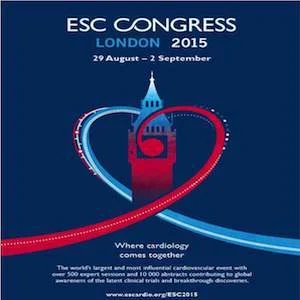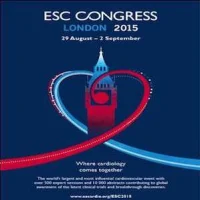Patients with atrial fibrillation who receive antithrombotic management according to ESC guidelines have better outcomes than those who do not, according to one year follow up results from the ESC’s EORP-AF Pilot General Registry presented at ESC Congress 20151 and published online in Europace.
“This is the first study to show better outcomes using the 2012 ESC guidelines on atrial fibrillation,” said principal investigator Professor Gregory YH Lip, from the University of Birmingham, UK and Aalborg University, Denmark.3 “This is novel as the 2012 guidelines – for the first time - focused on the initial identification of ‘low risk’ patients (that is, CHA2DS2-VASc score 0 in men, 1 in women) who did not need any antithrombotic therapy, following which oral anticoagulation can be offered to those with one or more stroke risk factors. Older guidelines had a categorical approach to stroke risk stratification and treatment decisions were more focused on identifying ‘high risk’ patients to be targeted for oral anticoagulation treatment but many patients were suboptimally untreated.”
The EURObservational Research Programme4 Pilot survey on Atrial Fibrillation (EORP-AF Pilot) previously reported a high rate of oral anticoagulant use (nearly 80%) which was reflected in low overall rates of stroke and thromboembolism during follow up.5
One year results from the EORP-AF Pilot General Registry are presented today. The analysis assessed whether atrial fibrillation patients at high risk of stroke received antithrombotic therapy management that adhered to ESC guidelines, or whether they were over-treated or under-treated. Patients were deemed at high stroke risk if they had a CHA2DS2-VASc score ≥2 or recent acute coronary syndrome (ACS)/stent or were scheduled for cardioversion.
The researchers also investigated differences in characteristics between guideline adherent, over-treated or under-treated patients who were at high risk, and the associated adverse outcomes at one year.
The registry comprised of 2 634 patients with atrial fibrillation diagnosed by ECG from nine countries who were enrolled in 2012 and 2013. Of these, 2 460 were at high risk of stroke and included in the present analysis. The endpoint of any thromboembolism (TE) was defined as stroke, transient ischaemic attack (TIA), acute coronary syndrome (ACS), coronary intervention, cardiac arrest, peripheral embolism and pulmonary embolism.
The researchers found that 1 602 atrial fibrillation patients at high risk of stroke (60.6%) were guideline adherent, 458 (17.3%) were under-treated and 574 (21.7%) were over-treated. High risk patients who received guideline-adherent antithrombotic treatment had significantly lower rates of major adverse events during one year follow up than those who were over- or under-treated. Guideline-adherent patients had a 3.2% rate of ‘any TE’ compared to 5.1% and 6.0% in the under- and over-treated patients, respectively (p=0.0259). Significantly lower rates of the composite endpoints of ‘all cause death and any TE’ (p=0.0009) and ‘cardiovascular death, any TE or bleeding’ (p=0.0118) were also observed in the guideline-adherent group.
The endpoint of ‘all cause death and any TE’ increased by more than 60% in under- (hazard ratio[HR]=1.679, 95%confidence interval[CI]=1.202-2.347, p=0.0022) and over-treated (HR=1.622, 95%CI=1.173-2.23, p=0.0032) patients compared to those receiving therapy that adhered to guidelines. Under-treatment increased risk by more than 70% for the composite endpoint of ‘cardiovascular death, any TE or bleeding’ (HR=1.722, 95%CI=1.200-2.470, p=0.0029).
“We previously showed that more than 80% of patients in the registry were receiving oral anticoagulation,” said Professor Lip. “But the results presented today reveal that inappropriate use of oral anticoagulation can be harmful, with a more than 60% increase in all cause death and any thromboembolism in patients who were under- or over-treated.”
He concluded: “Stroke prevention is central to the management of atrial fibrillation. Our analysis emphasises the importance of adhering to oral anticoagulation guidelines, which reduce stroke and save lives. Furthermore, we have shown that the CHA2DS2-VASc risk based approach to identifying patients for antithrombotic therapy – with the initial focus on identifying low risk patients as recommended in the 2012 ESC atrial fibrillation guidelines - works well and guidelines adherence translates to improved outcomes.”
Source: ESC
Image Credit: ESC










